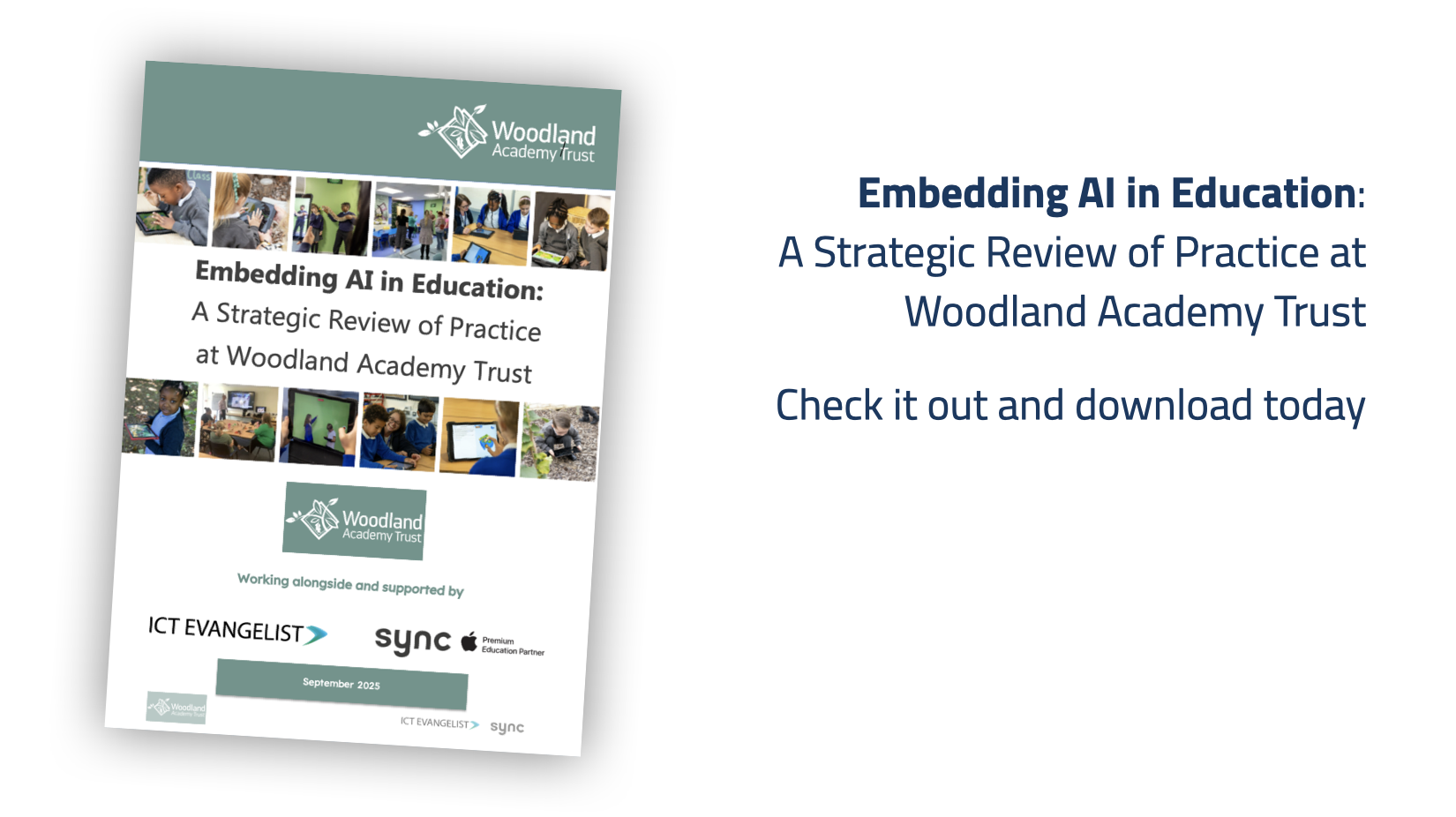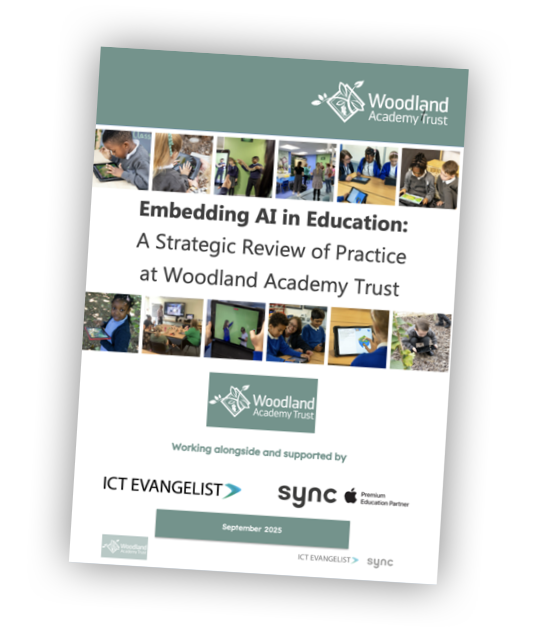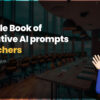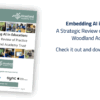
I am absolutely thrilled to share today the publication of ‘Embedding AI in Education: A Strategic Review of Practice at Woodland Academy Trust‘, a report that Julie Carson (Director of Education at Woodland Academy Trust) and I have co‑authored after a year‑long consultancy and training partnership. Our aim was simple: to explore how generative AI could responsibly support teachers, reduce workload and improve learning across all schools in the Trust. We focused not on hype, but on evidence. The evaluation centred on three core questions: Does AI reduce teacher workload? Does it improve pupil engagement? Does it enhance pupil outcomes? We also looked for inclusive practice benefits such as accessibility and differentiation.
I’m often lucky enough to be proud of my work, but with this report, I’m so proud of the achievements of the colleagues I’ve worked with within the Woodland Academy Trust, and I really couldn’t be happier with the report.

The report is a deeply data‑rich picture of how AI, when thoughtfully integrated, can make teaching more efficient, learning more engaging and classrooms more inclusive. Below, I highlight some of the key outcomes, then share a few examples of the tools we used and the teacher voices behind them.
Impact on Teacher Workload and Well‑being
One of the most immediate benefits we observed was a dramatic reduction in planning time. Average weekly lesson‑planning time dropped from 10 hours to 4.75 hours – a 52.5% reduction, saving more than five hours per teacher per week. Median planning time fell from seven to four hours (a 42.9% drop), and the maximum fell from 24 to 10 hours. Staff perceptions shifted too, with 88% describing their planning as efficient or very efficient.
Importantly, these time savings translated into a lighter workload and better well-being. The proportion of staff who said lesson planning had a “high impact” on workload fell from 75% to 0%, while 75% now report it has “low impact”. Similarly, feelings of being overwhelmed by planning time dropped from 75% of teachers reporting “always” or “often” to 0%, with 75% now “rarely” or “never” feeling overwhelmed.
Time freed up by AI wasn’t lost but enabled teachers to do what they love. One teacher noted that AI “reduced my administrative burden, allowing me to focus more on student engagement and assessment”, while another said it enabled them to allocate more time to teaching and learning. Confidence also rose: 88% of teachers now rate themselves as confident planners, up from 50% initially, and 100% feel their planning meets the needs of their classes.
Pupil Engagement and Agency
Alongside workload gains, we saw striking improvements in pupil engagement and independence. A follow‑up survey found that 82% of teachers reported increased pupil engagement in AI‑informed lessons, and 78% observed greater learner independence, particularly where tasks were clearly scaffolded. Moreover, 91% of KS2 pupils said they preferred lessons that involved “new ways of thinking” or “more surprising activities”.
These statistics were borne out in classrooms. Teachers noted that AI tools facilitated real‑time differentiation; for example, by using Magma Maths, teachers could instantly see which pupils had understood a concept and adjust grouping or pace accordingly. Pupils became active participants, sometimes even shaping AI prompts themselves. In one Year 4 writing lesson, children wrote their own prompts for a text‑to‑image AI, giving them a sense of ownership over the content. Another case saw a pupil with an EHCP complete a science investigation unaided using an AI‑generated visual instruction sheet, having never before finished a task independently. These examples show how AI can support agency, curiosity and inclusivity without reducing professional control.
Inclusive Practice and Equal Access
AI also played a key role in levelling the playing field. Teachers working in high‑Pupil Premium contexts used AI to generate resource‑light, differentiated tasks: prompt‑based discussions requiring no printing, audio‑scripted storytelling for oral retelling, or scaffolded tasks on shared iPads. Data snapshot figures underline this impact: 95% of teachers using AI to support EAL or disadvantaged learners reported it increased the speed and quality of differentiation, while 89% said AI provided more equitable access to learning without lowering expectations. A Year 6 teacher described creating three versions of a maths problem (for different reading levels) in under ten minutes, meaning every pupil could tackle the same question “their way”.
These shifts went beyond efficiency. By easily tailoring content, teachers could maintain high expectations while meeting diverse needs. Universal Design for Learning wasn’t just a theory; AI made it practical, allowing more pupils to access, process and express ideas through multiple modalities.
Products in Context
While the report’s focus was squarely on outcomes, it’s useful to see how particular tools contributed. Each played a different role within the wider strategy:
Canva helped teachers quickly create inclusive visuals. Staff reported that AI‑powered templates and tools made it easier to produce clear, accessible resources and saved huge amounts of preparation time. One teacher said, “It saves huge amounts of time — I can produce inclusive, well‑presented resources in minutes.” That freed up time to focus on teaching rather than formatting.
Magma Maths provided real‑time insight. By analysing pupils’ answers instantly, teachers could adapt groupings and support on the spot. As one colleague put it: “Recording of a child’s working out means I can see exactly where mistakes are happening and address it.” That immediacy made assessment truly formative, improving pacing and challenge.
Olex accelerated feedback loops in literacy and humanities. Its text‑analysis and text‑to‑image functions helped teachers highlight structural issues in writing and plan the next lesson accordingly. A teacher reflected, “It’s like the marking finally leads somewhere — straight into planning.” Pupils responded well too, saying they felt motivated to act on feedback.
TeachMate AI supported planning structure and prompted deeper thinking. Early career teachers, in particular, valued the ready‑made frameworks that reminded them to consider questioning, differentiation and adaptive teaching. One commented, “It gives me a clear structure and prompts me to think about questioning and support.” Rather than replacing professional judgement, it provided a starting point for reflection.
These tools were not the focus of the research; they were the means by which we explored AI impact on workload, engagement and inclusion. The key message is that AI, used thoughtfully and ethically, can enhance planning and learning across multiple dimensions, but it must always be guided by pedagogy.
A Few Words from Julie
Julie Carson reflects on our partnership in the report:
“Mark’s work with Woodland Academy Trust has been transformational. His expertise, guidance and empathy have helped us build confidence, competence and consistency in how we approach AI across all our schools. What began as training has become genuine cultural change, empowering staff, improving teaching and learning, and helping us see AI as a tool to enhance, not replace, great teaching.”
Like most EdTech, and other technologies, AI isn’t a silver bullet, but it can be a powerful ally when supported by professional development, ethical safeguards and a clear focus on outcomes.
Final Thoughts
The Woodland Academy Trust project shows that embedding AI in education, like lots of things, is less about the technology and more about strategic thinking, change management and working closely on relationships with people. I once said; “When you use technology as a gimmick it devalues everything. Focus on deep thinking and learning.”
By focusing on teacher workload, pupil engagement, equitable access and learning outcomes, we have seen how AI can make a tangible difference; not by taking over, but by freeing up time and thinking space for what matters most.
If you’d like to delve deeper, the full report is available to download brlow and contains richer detail on methodology, data and case studies. If you’re looking to embark on a similar journey, I’m always happy to talk about how we can make AI work for you and your pupils. You can get in touch here.
Download the report
The report is freely available to download and will be launched today at the Confederation of School Trusts Conference 2025 at the ICC in Birmingham today. My thanks to Sync who have supported this project and who are kindly hosting the report here.














